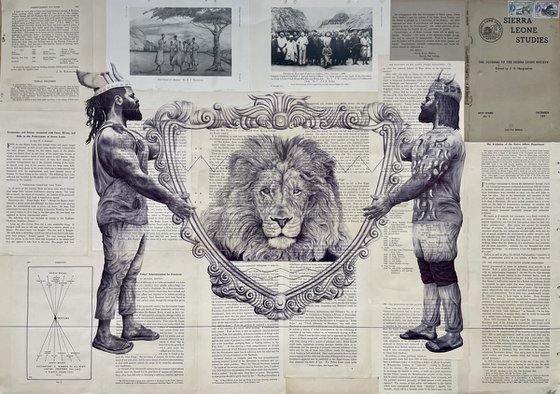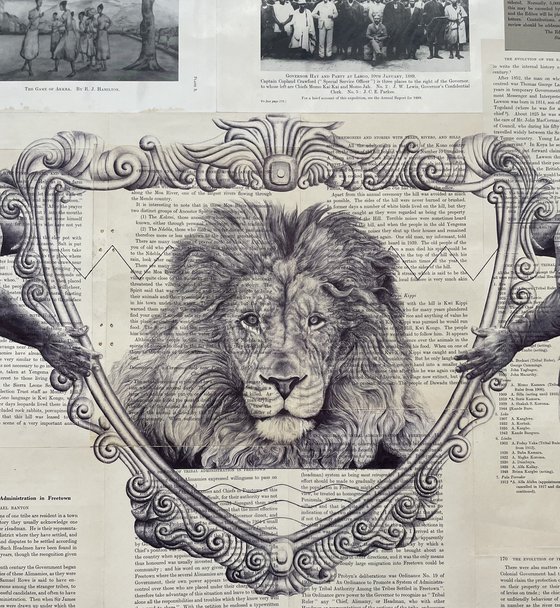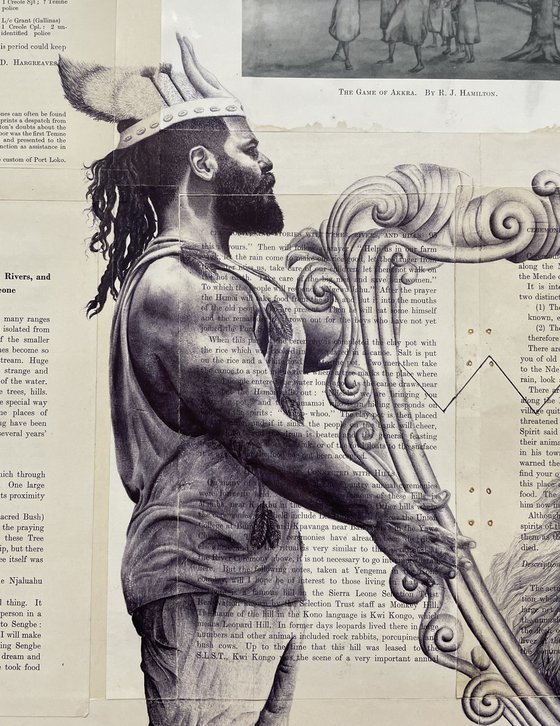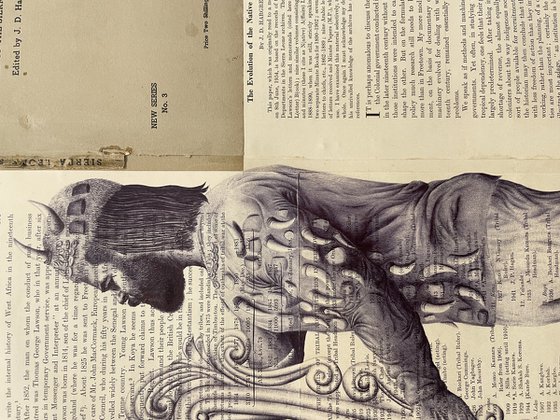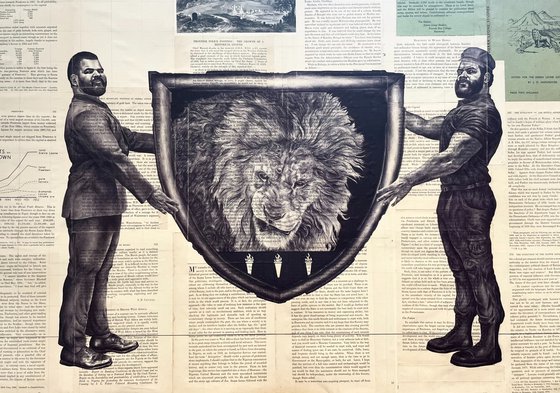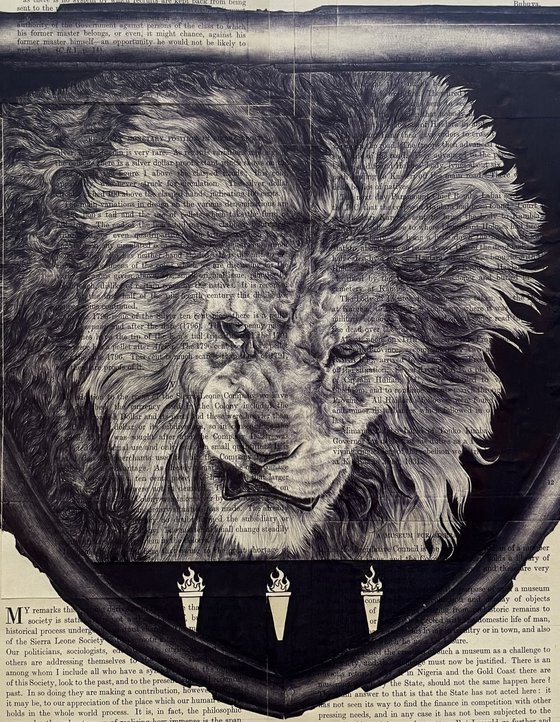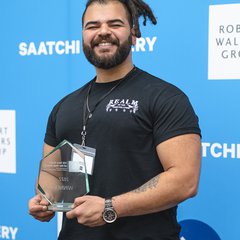- By medium
- By subject
- By budget
- Sales
- Gift cards
- Discover all art
- Artists
- Editors’ picks
- Ideas
Original artwork description:
‘Salone’ is a colloquial term for Sierra Leone. This diptych looks to celebrate the somewhat obscure great pioneering tribal leaders of Sierra Leone from the 16th & 17th century; whilst explicitly contrasting such figures with the condemned leaders of the rebel army that led to a decade of atrocities during the Sierra Leone civil war which shook the nation to the core. Within this quasi-surrealist self portrait diptych, I have recreated two ‘coat of arms’ which embody notions of pride, unity & prosperity with that of corruption, discord & oppression.
I have adopted the attire of what a rebel leader typically would have worn and a suit with a disingenuous smile in the role of Charles Taylor, the former Liberia president who played a crucial role in supporting the rebels known as The Revolutionary United Front (RUF). Initially the RUF’s message was to oppose to the corruption of politcians in the late 20th century, with their slogan being “No more Slaves, No More Masters. Power and Wealth to the People”. This message of equality was short lived and they would soon be known for their extreme cruelty & violence, inflicting crimes against humanity during a decade long war (1991-2002).
The burnt and damaged frame is symbolic of the destruction the rebel forces inflicted upon innocent members of the population. Lions usually act as motifs of strength and courage, they are integral in the Sierra coat of arms - but this lion is cowardly and deceptive, the three flames in the foreground are emblematic of hope for the nation’s future.
The motto depicted on the Sierra Leone coat of arms is ‘unity, freedom, justice’. Often notions of discord, oppression and corruption are associated with Sierra Leone, my family’s motherland, this work conversely looks to celebrate what it means to be Sierra Leonean from the perspective of the African diaspora.
Usually former British colonies are considered in relation to a period of time relative to their colonisation, with the pre-colonial history disregarded. Within this self portrait, I assume the attire of two figures who contributed to the development of Sierra Leone in the 16th and 17th century respectively, Farma Tami and Mansa Kama.
Farma Tami founded the Temne tribe, of which my family are descendants of, in the mid 16th century. He was known as The Great Mane Conqueror. He was one of the leaders of the Mane invaders in the early 1500s; historians reference the warriors’ advanced concepts of government and improved methods of weaving and manufacturing iron. Farma Tami organised and empowered his people.
Mansa Kama was known as a Great Koranko Warrior and was for all intents and purposes a king of his people. He led the Koranko into what is modern day Tonkolili, Sierra Leone in the mid 17th century. Remembered as the epitome of a brave pioneer, the Temne tribe in the 19th century retained a version of his name to be used as the title of the tribe’s ruler, Masakma.
The ornate frame holds within it a majestic lion with zigzag lines in the background representative of the Lion Mountains, where the name Sierra Leone originates. The two figures, drawings of myself, dressed as Farma Tami and Mansa Kama hold up the frame, as a clear motif paying homage to their legacy.
Whilst creating this work over the course of several months I was constantly focused on the message that I was trying to portray, which is that Sierra Leone is a nation that should not be defined by the atrocious and sickening acts of the rebels, but rather a resilient nation that is prosperous.
I felt uncomfortable as one does whilst confronting in depth the histories of a painful past which affected many members of my family. I believe it is important to remember that which causes us the most pain, we must not forget the tens of thousands of civilians who were murdered. The generations that proceeded this war must tell their story so such tragedies may never affect the motherland again.
This ballpoint pen artwork is drawn on pages from a 1954 Sierra Leonean text.
84X59cm each
Materials used:
ballpoint pen on antique text
The Salone Dichotomy (diptych) (2022) Ink drawing
by Habib Hajallie
1 Artist Reviews
£30,000
- Ink drawing on Paper
- One of a kind artwork
- Size: 86 x 125 x 2cm (framed)
- Framed and ready to hang
- Signed on the front
- Style: Surrealistic
- Subject: People and portraits
Loading
Original artwork description
‘Salone’ is a colloquial term for Sierra Leone. This diptych looks to celebrate the somewhat obscure great pioneering tribal leaders of Sierra Leone from the 16th & 17th century; whilst explicitly contrasting such figures with the condemned leaders of the rebel army that led to a decade of atrocities during the Sierra Leone civil war which shook the nation to the core. Within this quasi-surrealist self portrait diptych, I have recreated two ‘coat of arms’ which embody notions of pride, unity & prosperity with that of corruption, discord & oppression.
I have adopted the attire of what a rebel leader typically would have worn and a suit with a disingenuous smile in the role of Charles Taylor, the former Liberia president who played a crucial role in supporting the rebels known as The Revolutionary United Front (RUF). Initially the RUF’s message was to oppose to the corruption of politcians in the late 20th century, with their slogan being “No more Slaves, No More Masters. Power and Wealth to the People”. This message of equality was short lived and they would soon be known for their extreme cruelty & violence, inflicting crimes against humanity during a decade long war (1991-2002).
The burnt and damaged frame is symbolic of the destruction the rebel forces inflicted upon innocent members of the population. Lions usually act as motifs of strength and courage, they are integral in the Sierra coat of arms - but this lion is cowardly and deceptive, the three flames in the foreground are emblematic of hope for the nation’s future.
The motto depicted on the Sierra Leone coat of arms is ‘unity, freedom, justice’. Often notions of discord, oppression and corruption are associated with Sierra Leone, my family’s motherland, this work conversely looks to celebrate what it means to be Sierra Leonean from the perspective of the African diaspora.
Usually former British colonies are considered in relation to a period of time relative to their colonisation, with the pre-colonial history disregarded. Within this self portrait, I assume the attire of two figures who contributed to the development of Sierra Leone in the 16th and 17th century respectively, Farma Tami and Mansa Kama.
Farma Tami founded the Temne tribe, of which my family are descendants of, in the mid 16th century. He was known as The Great Mane Conqueror. He was one of the leaders of the Mane invaders in the early 1500s; historians reference the warriors’ advanced concepts of government and improved methods of weaving and manufacturing iron. Farma Tami organised and empowered his people.
Mansa Kama was known as a Great Koranko Warrior and was for all intents and purposes a king of his people. He led the Koranko into what is modern day Tonkolili, Sierra Leone in the mid 17th century. Remembered as the epitome of a brave pioneer, the Temne tribe in the 19th century retained a version of his name to be used as the title of the tribe’s ruler, Masakma.
The ornate frame holds within it a majestic lion with zigzag lines in the background representative of the Lion Mountains, where the name Sierra Leone originates. The two figures, drawings of myself, dressed as Farma Tami and Mansa Kama hold up the frame, as a clear motif paying homage to their legacy.
Whilst creating this work over the course of several months I was constantly focused on the message that I was trying to portray, which is that Sierra Leone is a nation that should not be defined by the atrocious and sickening acts of the rebels, but rather a resilient nation that is prosperous.
I felt uncomfortable as one does whilst confronting in depth the histories of a painful past which affected many members of my family. I believe it is important to remember that which causes us the most pain, we must not forget the tens of thousands of civilians who were murdered. The generations that proceeded this war must tell their story so such tragedies may never affect the motherland again.
This ballpoint pen artwork is drawn on pages from a 1954 Sierra Leonean text.
84X59cm each
Materials used:
ballpoint pen on antique text
14 day money back guaranteeLearn more
